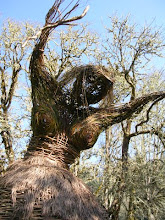About the Birds: Poetry Month
and Earth Day
Since I seem
to be derelict (or busy) regarding this blog, and considering that April is
National Poetry Month here in the USA, perhaps it is time to share a few of my
poems. And since it is also Earth Day, poems about wild birds seems
appropriate.
Please note
that these poems are all copyright in my name.
My young
neighbor, years ago, was passionate about raptors and had permissions from
National authorities to hold and treat wild species. At any given time you
might find Golden Eagles, Bald Eagles, Red-tailed Hawks, and other birds of
prey in his aviaries. Cornell flew experts out to perform surgeries in extreme
cases. And sometimes he worked with local wildlife vets to rehabilitate some
wild birds. He once stopped by my place to show me a pygmy owl that had bumped
into a car windshield that he was asked to treat and was transporting to his
home up the hill. It recovered quickly, mostly from shock. The heron he tried
to save didn’t make it, but I watched while he made the attempt to force-feed
it. (He has since become a nationally recognized wild bird specialist with “Dr.”
in front of his name.)
Feeding the Heron
I
remember how my neighbor’s boy
tried to save the blue heron --
damaged, starving – entrusted
to
his care; how he trussed its wings
against
the bulky body, then forced
that
long sharp bill apart
to
dribble in warm brandy
while
his dark and gentle hand
stroked
the slender throat
from
pharynx to crop. “You don’t
dare
move your eyes,” he said,
then
told how the stiletto beak
would
strike in an instant
at
a moist eye’s flash
as
though it were a minnow under water.
Watching a documentary on Bald Eagles, the first flight of a fledgling
captured my heart.
She Soars
the
eaglet
born
to
fly
has
never
flown
before
her
knotty
feet
cling
to
the aerie
the
first
time
she
must
get
it
right
a half-
mile
down
the
earth
is
bright
in
her
youthful
eye
she
lifts
her
wings
feels
insistent
wind
suck
seductive
she
shifts
her
feet
the
untried
wings
vibrate
hesitate
paper
kites
updrafts
surge
she
cups
the
wind
presses
it
against
her body
feels
it
squirt
away
she
captures
air
masters
flight
that
suddenly
released
from
earth
she
soars
brilliant
light
limns
her
head
her
back
strikes
fire
in her
golden
eye
she
soars
she
soars
oh
for
those
wings
those
wings
that
air
that
light
A Few Words and a
Poem About Starlings
Starlings are not native to North
America. They were introduced in 1890-91 by the American Acclimatization
Society (for questionable reasons). The chairman at the time, Eugene
Shieffelin, supposedly decided that all birds mentioned by Shakespeare should
be included. 100 starlings were released in Central Park, Manhattan. Since then
they have multiplied and spread across the country from coast to coast. Social
birds, they frequently roost in the tens of thousands, creating noise and
coating everything below with droppings. They also destroy the eggs or consume
the resources of native birds, contributing to the decline of native species.
Related to the Mynah birds of Asia,
they are terrific mimics and are even being studied in attempts to discover the
evolution of language.
No matter how people feel about them,
few fail to respond with awe to a flocking phenomenon known as murmuration.
There are a number of videos on UTube showing these awesome group flights. One observer
claims that after watching dozens of these performances, he has yet to see a
collision.
http://www.youtube.com/watch?v=rJtgE9FhRQ
Murmurations occur mostly in winter, before pairing off begins. As mating season approaches, the beaks turn bright yellow.
Murmurations occur mostly in winter, before pairing off begins. As mating season approaches, the beaks turn bright yellow.
STARLING
PERSPECTIVES
Starlings
are mathematicians
of a
different dimension.
They
accept no straight lines:
all
things are approached obliquely.
What
appears from here
to be
a crust of bread
may
be, from a different angle,
a
stone, a cat, an old shoe
filled
to its rim by a foot.
You
can't take anything for granted
(if
you're a starling.) Given
the
gift of song, there is still need
to
experiment with whistles, beeps,
the
cheeping of a chick,
screech
of rusty door hinge,
a cat's
betrayed meow.
Flight
is a matter of angles,
of
reversed decisions
made
in attitudes of air.
For
one bird to falter
in
this erratic rhythm
would
spell disaster for the flock.
Imagine
the collision:
yellow-beaked
birds
falling for weeks like rain.






No comments:
Post a Comment